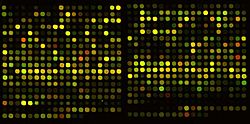
Back دنا متمم Arabic Komplementarna DNK BS ADN complementari Catalan CDNA Danish CDNA German CDNA Greek ADN complementario Spanish دیانای مکمل Persian CDNA Finnish ADN complémentaire French
This article needs additional citations for verification. (October 2010) |

In genetics, complementary DNA (cDNA) is DNA that was reverse transcribed (via reverse transcriptase) from an RNA (e.g., messenger RNA or microRNA). cDNA exists in both single-stranded and double-stranded forms and in both natural and engineered forms.
In engineered forms, it often is a copy (replicate) of the naturally occurring DNA from any particular organism's natural genome; the organism's own mRNA was naturally transcribed from its DNA, and the cDNA is reverse transcribed from the mRNA, yielding a duplicate of the original DNA. Engineered cDNA is often used to express a specific protein in a cell that does not normally express that protein (i.e., heterologous expression), or to sequence or quantify mRNA molecules using DNA based methods (qPCR, RNA-seq). cDNA that codes for a specific protein can be transferred to a recipient cell for expression as part of recombinant DNA, often bacterial or yeast expression systems.[1] cDNA is also generated to analyze transcriptomic profiles in bulk tissue, single cells, or single nuclei in assays such as microarrays, qPCR, and RNA-seq.
In natural forms, cDNA is produced by retroviruses (such as HIV-1, HIV-2, simian immunodeficiency virus, etc.) and then integrated into the host's genome, where it creates a provirus.[2]
The term cDNA is also used, typically in a bioinformatics context, to refer to an mRNA transcript's sequence, expressed as DNA bases (deoxy-GCAT) rather than RNA bases (GCAU).
Patentability of cDNA was a subject of a 2013 US Supreme Court decision in Association for Molecular Pathology v. Myriad Genetics, Inc. As a compromise, the Court declared, that exons-only cDNA is patent-eligible, whereas isolated sequences of naturally occurring DNA comprising introns are not.
- ^ Hastings, P. J. (1 January 2001), "Complementary DNA (cDNA)", in Brenner, Sydney; Miller, Jefferey H. (eds.), Encyclopedia of Genetics, New York: Academic Press, p. 433, ISBN 978-0-12-227080-2, retrieved 29 November 2022
- ^ Croy, Ron. "Molecular Genetics II - Genetic Engineering Course (Supplementary notes)". Durham University durham.ac.uk; 20 April 1998. Archived from the original on 24 August 2002. Retrieved 4 February 2015.
© MMXXIII Rich X Search. We shall prevail. All rights reserved. Rich X Search